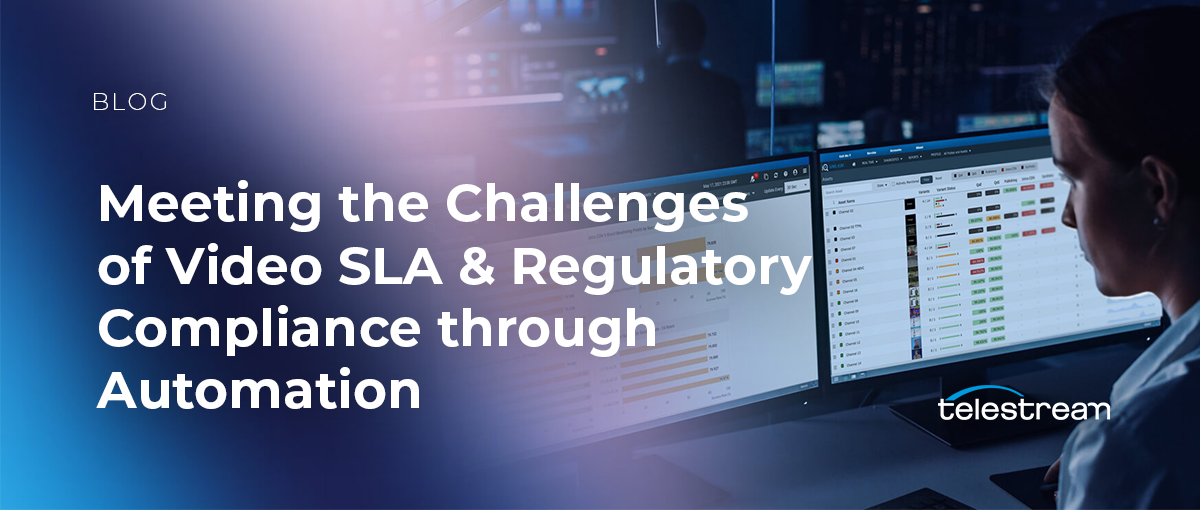For premium video content suppliers and their distribution affiliates, ensuring video SLA & regulatory compliance, especially with a rising tide of contractual terms and regulations, is a daunting challenge. Luckily, there’s some much-needed relief in sight.
TV networks and multichannel video programming distributors (MVPDs) have dealt with content licensing agreements and ad fulfillment commitments for decades. In an age of streaming video service delivery, with dynamic advertising and unrelenting piracy, adhering to policies spelled out in service level agreements (SLAs) is increasingly burdensome. Moreover, compliance oversight complexities have intensified with an outpouring of region-specific video service regulations.
To keep pace with this explosion in SLA and regulatory requirements, a good starting point is adopting a market-wide, automated approach to compliance management, collecting and analyzing data across all key areas. Content suppliers need to track compliance to avoid reliance on the accuracy of distributors’ reports; distributors need to back their video SLA & regulatory compliance reporting with credible data to stand up to any challenges.
A New Way Forward
Many media and entertainment entities have begun, or have already been well underway, migrations to the cloud. These migration efforts yield many benefits for these organizations. By implementing a centralized monitoring management system with analytic probes, such as Telestream’s Video Quality Monitoring solution, content suppliers and distributors can expect to maintain higher-quality video service performance from end to end, with video SLA & regulatory compliance monitoring across all content flows.

The ARGUS central management system can correlate data generated by hundreds of Telestream analytics probes positioned at key points of contribution ingest, playout, and video delivery. This includes delivery across all streaming and linear TV services. ARGUS delivers actionable insights for thousands of programs that may be running at any given moment across content suppliers and their service provider affiliates. Telestream’s Video Quality Monitoring workflows can also automatically provide regular reports specific to each contractual or legal nuance. Plus, the platform’s open APIs can be leveraged to automatically funnel data for specific compliance issues addressed by any third-party analytics tools service providers have in use.
There are many daunting complexities of video SLA & regulatory compliance across a chaotic sea of shifting contract terms. But with a cloud-native solution, entities on both sides of the deal-making table can benefit from a cloud-orchestrated approach to ensuring optimal quality monitoring and data analysis. Telestream’s Video Quality Monitoring solutions can help you overcome the ever-evolving and complex landscape of tracking and validating video SLA & regulatory compliance. In fact, these capabilities are instrumental to maintaining operational efficiency and healthy financial performance, especially in today’s crowded video services marketplace.
The Video SLA & Regulatory Compliance Challenge
There is an unprecedented variety of contractual commitments that content providers need to meet. That’s not to mention that growing catalogs of content can have widely varying and unique requirements on a per-asset basis. Video service operators are similarly encumbered, with expanding lists of contract terms from content suppliers that they need to document and follow. Players on both sides are wary of penalties from erroneous metrics gathered by sources in performance-based transactional relationships, like those used by advertisers.

SLA monitoring and analysis must be able to assess adherence to contract policies with each distributor for each piece of content, including requirements related to:
- Release windows
- Geographic constraints
- Formatting parameters
- Duration of availability
- Use of feature enhancements
- Device access restrictions within and beyond the household
- Time-shift policies
- CDN performance and validation of service charges
- Content Protection1
1 This includes content protection methods that are provided by digital rights management (DRM) and conditional access (CA) systems. It also includes forensic watermarking to help combat video piracy, which drains $50 billion+ annually.
These contractual complexities result in costly delays. Historically, content providers relied on distributors to set up and manage auditing procedures, and provide hard-copy reports on fulfillment. This represents an intolerable burden for content providers. Licensing revenue is directly at stake when they cannot have a timely picture of all the distribution details.
Reducing Revenue Loss from Ad Failures
A lot can go wrong in dynamic addressable advertising. Ads are inserted on a per-stream basis to facilitate better targeting. The adaptive bitrate (ABR) streaming process generates timely responses from ad servers, delivering frame-accurate placement at network edges. Indeed, research shows poorer ad performance in the dynamic streaming services advertising space than with traditional TV services.
There’s a growing need for more efficient, rapid performance validation for ads. Content suppliers and service providers already have the tools they need to gauge viewership across all viewing platforms. But cross-platform SLA monitoring is essential for measuring compliance with ad placement accuracy commitments and billing ad buyers.
Over the past three years, Convivia’s global assessments have registered average quarterly ad failure rates ranging from 15% to 40%. This amounts to billions of dollars in annual losses in a $33 billion ad market in 2021, according to Digital TV Research. By and large, content suppliers and distributors are losing revenue in the form of missed impressions on the ads. Plus, they’re incurring revenue losses tied to deductions, rebates, and makegoods granted by advertisers.

Accordingly, comprehensive monitoring and analysis capabilities are indispensable, whether to ensure accurate charges for ad placements or to cut losses from failed ones. Fortunately, Telestream’s cloud-native Video Quality Monitoring solutions mitigate these losses from poor ad performance.
The Key Takeaways
Video SLA & regulatory compliance issues are a thorn in the side of content suppliers and distributors. They need reliable, automated, efficient workflow solutions for monitoring and analyzing compliance. Telestream’s cloud-native Video Quality Monitoring solutions provide an end-to-end approach for high-quality video performance monitoring and workflow orchestration. Addressing demands across all screens, this is a major win/win in the modern era of network entertainment. For more information, visit https://www.telestream.net/iq/overview.htm

